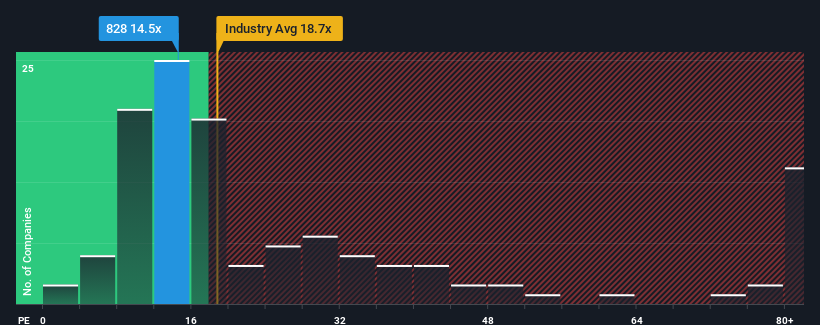
When close to half the companies in Hong Kong have price-to-earnings ratios (or "P/E's") below 10x, you may consider Dynasty Fine Wines Group Limited (HKG:828) as a stock to potentially avoid with its 14.5x P/E ratio. Although, it's not wise to just take the P/E at face value as there may be an explanation why it's as high as it is.
Our free stock report includes 1 warning sign investors should be aware of before investing in Dynasty Fine Wines Group. Read for free now.With earnings growth that's exceedingly strong of late, Dynasty Fine Wines Group has been doing very well. The P/E is probably high because investors think this strong earnings growth will be enough to outperform the broader market in the near future. You'd really hope so, otherwise you're paying a pretty hefty price for no particular reason.
Check out our latest analysis for Dynasty Fine Wines Group

Is There Enough Growth For Dynasty Fine Wines Group?
There's an inherent assumption that a company should outperform the market for P/E ratios like Dynasty Fine Wines Group's to be considered reasonable.
If we review the last year of earnings growth, the company posted a terrific increase of 46%. However, this wasn't enough as the latest three year period has seen a very unpleasant 9.7% drop in EPS in aggregate. Therefore, it's fair to say the earnings growth recently has been undesirable for the company.
Weighing that medium-term earnings trajectory against the broader market's one-year forecast for expansion of 18% shows it's an unpleasant look.
With this information, we find it concerning that Dynasty Fine Wines Group is trading at a P/E higher than the market. It seems most investors are ignoring the recent poor growth rate and are hoping for a turnaround in the company's business prospects. Only the boldest would assume these prices are sustainable as a continuation of recent earnings trends is likely to weigh heavily on the share price eventually.
What We Can Learn From Dynasty Fine Wines Group's P/E?
Generally, our preference is to limit the use of the price-to-earnings ratio to establishing what the market thinks about the overall health of a company.
Our examination of Dynasty Fine Wines Group revealed its shrinking earnings over the medium-term aren't impacting its high P/E anywhere near as much as we would have predicted, given the market is set to grow. When we see earnings heading backwards and underperforming the market forecasts, we suspect the share price is at risk of declining, sending the high P/E lower. Unless the recent medium-term conditions improve markedly, it's very challenging to accept these prices as being reasonable.
Before you settle on your opinion, we've discovered 1 warning sign for Dynasty Fine Wines Group that you should be aware of.
Of course, you might find a fantastic investment by looking at a few good candidates. So take a peek at this free list of companies with a strong growth track record, trading on a low P/E.
Have feedback on this article? Concerned about the content? Get in touch with us directly. Alternatively, email editorial-team (at) simplywallst.com.
This article by Simply Wall St is general in nature. We provide commentary based on historical data and analyst forecasts only using an unbiased methodology and our articles are not intended to be financial advice. It does not constitute a recommendation to buy or sell any stock, and does not take account of your objectives, or your financial situation. We aim to bring you long-term focused analysis driven by fundamental data. Note that our analysis may not factor in the latest price-sensitive company announcements or qualitative material. Simply Wall St has no position in any stocks mentioned.